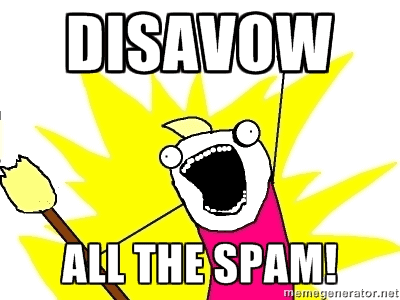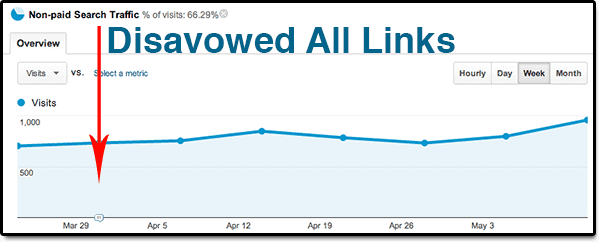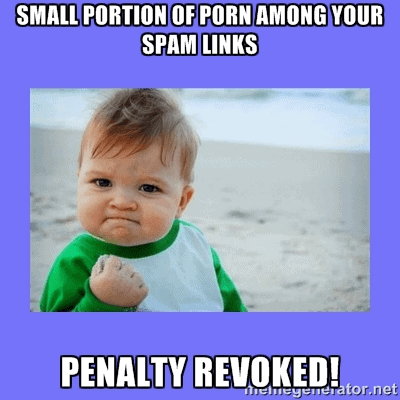The Long, Strange Disavow Journey
With the latest round of Google’s Penguin update, Penguin 2.1, going live just under two months ago, more and more sites have been hit due to some missteps in their past choices of SEO firms. These firms built tons and tons of low quality links to artificially boost their clients’ rankings and make a quick buck, but now, all of those clients are paying the price for their laziness. This is even more true given the proliferation of manual link penalties handed out by Google at around the same time.
Because of these factors, we’ve had a lot of requests from site owners and marketing directors of late asking us to clean out their link profiles and remove penalties applied to their sites where possible. We’ve been very successful of late, with 3 manual penalties removed in the past couple of months alone, and we expect even more success whenever Penguin 2.2 is released. Above all, we’ve all learned a ton by going through our internal process of compiling, analyzing, and disavowing links and filing reconsideration requests. Here are the top 7 takeaways for all you aspiring gurus of penalty removal:
1) You Can Never Have Too Many Link Sources
Google claimed back in June that addressing the spam found among the links downloadable from Webmaster Tools (WMT) was enough to get a penalty removed. Unfortunately, that simply doesn’t jive with the facts we’ve seen on the ground. To the contrary, we’ve found that the more link sources you can get your hands on, the better chance you have of getting a penalty removed. I personally use WMT, Moz’s Open Site Explorer, Majestic, and Ahrefs’ lists of links. The bottom line is that each tool has it’s limitations, and if you really want to eradicate all your spam, take the advice of Captain Planet and use all their powers combined.

2) Link Research Tools Is Awesome
After compiling the link list, we upload them to Link Research Tools’ Detox tool to get more information. After the tool does it’s thing, SEOs are left with an Excel spreadsheet choc full of juicy nuggets about each link: anchor text, follow/nofollow, location of the link, site type, basic contact information (if available) and much more! To be very honest, like my iPhone, I’m not sure how I survived without this tool before. About the only thing that could keep me away from it going forward is this spider mouse!

3) Old School SEOs Were Really Bad At Avoiding Clear Link Building Patterns
Another thing that Link Research Tools helped me do was identify clear link building patterns among each site’s links. Every shady SEO agency of the past had their methods, and they are all clearly visible in their clients’ backlink profiles. After going through 50 or so links, you can usually project what the rest of the backlinks in your list will look like. Whether it’s wiki sites, spam blog posts, article directories, fake press releases, you name it, it’ll usually pop out at you right away. The cool part is what you do with this information: using Excel’s column filters, you can try to identify URL patterns so that you can more easily discard the junk. Just make sure to have a once over first in case a legitimate site snuck in there.
4) 99% Of the Links On the Internet Are Spam
In life, there are lies, damned lies, and statistics. This section’s heading is one of the first two. That said, I think I *might* have a leg to stand on here. Hear me out for a second: if you’ve done a link analysis before, you know just how many link and article directories exist out there. Each one has thousands of links at the least! Throw in the spam blogs, spammed out forums, and the old paid link farms, and there are just too many spammy links to deal with. I’ve even seen spammy links and deeply buried linked posts on QUALITY BLOGS!

To drive my point home, we’ve disavowed a LOT of domains the past few months. Overall, I’d guess we disavowed 80-90% of our clients’ links. Of course, we monitor rankings more closely than normal for the next month or two after the disavow to make sure that nothing we disavowed was really valuable for our clients. Well, we’ve never seen a single rankings drop or other shred of evidence that these links were providing any equity. Then again, Cyrus Shephard of Moz tested disavowing ALL of a site’s links, and this is what happened:

NOTHING! So who knows for sure?
5) Mail Merges Are A Lifesaver
Once you’ve compiled the list of spammy links and the associated contact information, the last tedious detail remaining is to physically email each of the thousands of webmasters responsible for those sites and ask them to remove your links. But does it really have to be so tedious?
Once you’ve decided on a template, start a mail merge using Microsoft Word, the de-duped information from the Excel doc you’ve been working off of, and your Outlook-compatible client email address. Press send and Microsoft does the work for you! Alternatively, Amit Agarwal has a video on how to do this using Google Docs and Gmail!

With this method, I’ve gotten hundred of links removed in just days! Seriously, do this now!
6) Link Analysis Can Be NSFW
If you’re easily offended by pornographic images, perhaps examining the seedy underworld of internet link spam isn’t the best choice for you. Twice in the past few weeks, one of our associates, our resident professional spam spotter, has been making his way through link lists only to be assaulted by some images of a very graphic nature. Luckily for him, our Director of SEO was there to spot it the first time, and a very surprised office guest the second time. Our poor friend can’t catch a break!
Speaking of pornography…
7) Pornographic Links Can Sometimes Help Your Case
One redeeming quality of these pornographic links is that nobody in their right mind would build links to their site among pornographic content (unless, of course, their site *is* a porn site). From our experience, if you see a lot of these links, you can point them out to Google as part of your reconsideration request and get a small benefit of the doubt.

To show you what I mean, for one client we saw hundreds of pornographic links all pointed at one specific page on their site. My initial instinct was that the page in question had been hacked to include a link to a porn site in the past, and that the links we saw were second tier link building. Therefore, I advised the client to 404 that page and re-create it elsewhere. After I pointed it out in our reconsideration request – POOF! No more penalty. For another client, we had something similar, but we didn’t even 404 the page. We simply told Google that we didn’t build those links, and the penalty was revoked there as well.
I should be clear here: I am NOT advocating you blasting porn links at your site after you’ve been penalized so that you can use that as an excuse. I’m simply saying that you should use all of the already available information to help your case to Google going forward.
There Is No Silver Bullet
I hope all these tips gave you a better glimpse into the wild world of link analysis, disavows, and penalty removal.
Hundreds more tips have been documented by the awesome SEO community, but in the end of the day, disavowing is still a waiting game (especially when dealing with an algorithmic penalty) and no tip is a guarantee of success.
Finally, if you’ve got any more tips for us, please let us know in the comments or via email 🙂
